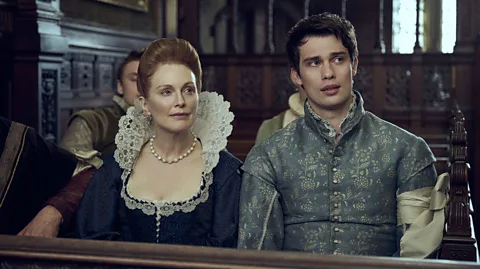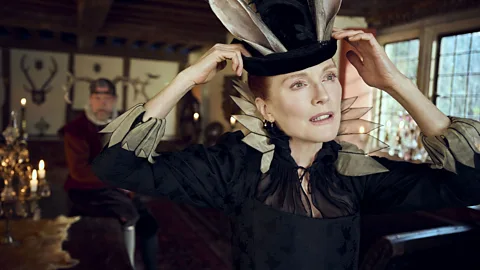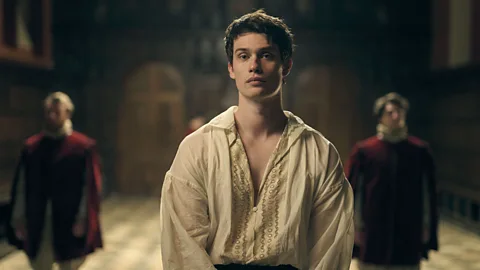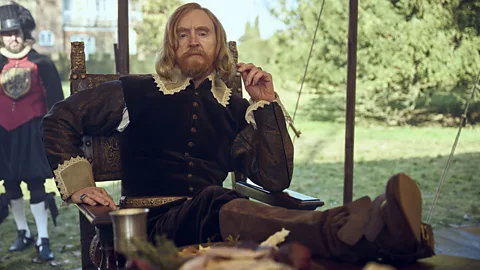Mary & George: The outrageous mother-and-son schemers who seduced a 17th-Century king
 Sky UK
Sky UKSocial climbers Mary and George Villiers used sex and skulduggery to become King James I's favourites. Julianne Moore and Nicholas Galitzine discuss playing them in a new series.
In a vast marquee tent outside Hatfield House, a stately home north of London, people sit eating lunch and checking their phones. It's a delicate operation, everyone trying to ensure that nothing spills on the lace or creases their skirts. Some are decked out in bibs, others in little rain capes (useful, given the lowering skies outside). Look down and it's a sea of heeled shoes. Look up and you'll see elaborate, pearl-studded hairstyles. When the rain finally sets in, it's decided that the extras will have to pile into minibuses to make the minute's walk to set. Damp patches on the gowns and doublets would be a disaster on camera.
More like this:
The logistical challenges of filming a costume drama are many and various, all the more so when that drama happens to be set during England's Jacobean era. Unlike the lusty, bloodthirsty, religiously fanatic Tudors, the comparatively short-lived reign of their successor King James I (who ruled Scotland as King James VI from 1567 to 1625, but England and Ireland for just 22 years, from 1603 until 1625) rarely makes it on to screen. Most of these costumes have therefore been made from scratch, an army of craftspeople working, under the resourceful eye of costume designer Annie Symons, to outfit a cast of hundreds. The drama is seven-part miniseries Mary & George, starring Oscar-winner Julianne Moore and heartthrob-of-the-moment Nicholas Galitzine – telling the real-life story of a mother-and-son duo who worked together to clamber the ranks at King James's court, and establish themselves – via sex, flattery, and a series of well-orchestrated schemes – as two of his closest advisors.
 Sky UK
Sky UKBased on Benjamin Woolley's 2017 biography The King's Assassin: The Secret Plot to Murder James I, it is a stylish, darkly humorous take on the period drama in the vein of Yorgos Lanthimos' and Tony McNamara's 2018 film The Favourite and McNamara's TV series The Great, full of machinations, salty insults, and acres of bare flesh. Scripted by Killing Eve's DC Moore and with the first three episodes directed by Oliver Hermanus, the South African filmmaker behind Moffie (2019) and the Oscar-nominated Living (2022), it dramatises the lives of the tenacious Mary Villiers (Moore) and her son George (Galitzine) – a man once described by Godfrey Goodman, Bishop of Gloucester, as "the handsomest-bodied man in all of England" – as they attempt, by a variety of methods, to seduce the king.
A bid for agency
"[Mary] is someone who has no autonomy and no agency, and no property, and no value, except through the men that she's married to, or her male children," Julianne Moore tells BBC Culture of her hard-nosed role. "There's something very overt about what she does… It's like: why not? Why not try?" Mary is the series' central force, as pragmatic as she is propulsive. "She sees with George that he's a proxy for her," Moore adds. "He's who she wishes she could be."
The daughter of a Leicestershire squire, the real Mary claimed to have noble ancestry but, with little family money or repute, began working as a "waiting woman" to a richer relative in her teens – and there met her future husband, landowner George Villiers. Their second son, also named George, was born in 1592. After her husband died, leaving her and her children with nothing, Mary took action. Scraping together the finances to give the good-looking, charming George the necessary skills for appearing in court (which the series vividly imagines him acquiring via a sojourn to France, all quite ooh la la with fencing lessons and orgies), she ensured that King James (Curran) quickly laid eyes on her 20-one-year-old son – first at a hunt, and later when George was appointed as a Royal Cup-bearer.
George Villiers soon grew close to the King, ousting previous favourite the Earl of Somerset, and acquiring a string of properties and titles that culminated in him becoming the Duke of Buckingham – the only person outside of the royal family to be appointed as an English Duke at that time. Where George moved, the rest of the family followed, Mary becoming a close consort and quasi-maternal figure for the king. The family were intimately involved in the king's decision-making both domestically and internationally.
Although historians can still be unduly squeamish when it comes to the labelling of sexual orientation, one doesn't even have to read that far between the lines to grasp the nature of this relationship. James I famously had a string of male favourites, and was once described by the historian Michael B Young as "the most prominent homosexual figure in the early modern period". In the letters they wrote to one another, James called George his "sweet child and wife" while George identified himself as "your most humble slave and servant and doge Steenie" (a nickname derived from St Stephen who was said to have "the face of an angel"). Evidence of James's relationship with George can still be traced in London today. A year on from filming, when the Mary & George press junket is held, it takes place in a hotel near Villiers Street, behind Charing Cross.
 Sky UK
Sky UKThe series toys with the immense draw and inherent vulnerability of power. In court, everyone is looking over one shoulder, hoping to advance their prospects without losing their footing (or their lives). At the centre of this web sits a paranoid king. Tony Curran, who plays James I, relays a conversation he had with Benjamin Woolley about what made the monarch tick. "He told me the term: 'nourished in fear'," Curran explains. "Daddy [Henry Stuart, Lord Darnley] being assassinated, Mama [Mary I of Scotland, Mary, Queen of Scots] being executed, [James having] been kidnapped as a child. He used to wear padding in his doublet around court in case anyone tried to stab him." Paranoia could make him volatile, but it also demanded closeness: a need to know who to trust, and who to shun.
There's plenty of plotting and double-crossing in Mary & George, but as it develops the series explores the more substantial feelings hinted at between James and George. "[Tony Curran and I] always talked about their relationship and… how much of it was transactional: how much of it was George climbing the social rungs," Galitzine tells BBC Culture. "But at a certain point there was a deep love and a care." It's a sentiment echoed by director Hermanus, who brings up the continued existence of Villiers Street. "The king was making it very public. One detail I kind of love was that Rubens painted George's ceiling of his house here in London. It's like this cliché gay thing – you get the best painter to do up your house," he says. "I laugh about that because George clearly had expensive tastes, kind of like a Jacobean gay housewife."
James I may have had good reason to fear those closest to him. According to Woolley's interpretation, Mary and George could have had something to do with his death – the latter allegedly poisoning the monarch with a dubious, potentially wolfsbane-laced "medicine" as he lay ailing in bed (the former's influence over the king was such she had already had one of his previous physicians dismissed). There is still a great degree of conjecture around his demise, but that is also the fun of a costume drama. It can pick up and flesh out the bones of fact and interpretation into something else, not just reading between the lines but scribbling into and over them, embellishing the details and adding in a lot more sex.
Should we judge them?
At its heart, Mary & George is about the wherewithal, social intelligence and stomach for threats and bribery required to better one's circumstances – at whatever cost. "Unfortunately, we seem to establish hierarchy, no matter where we are, every culture does it," Moore says. "And people have a tendency to want to move through hierarchy to get to the top." The term we might commonly use for this is 'social climbing', but there is something inherently judgemental in its wording – an implicit idea, perhaps, that it is less suspect to be born into immense privilege than to achieve it through effort.
 Sky UK
Sky UKGeorge Villiers was murdered three years after James died, aged 35. He was stabbed to death by John Felton, a discharged army officer who felt that he had been overlooked for a promotion by the Duke of Buckingham (whose reputation had soured enormously in more recent years). In the intervening centuries the Villiers family have remained woven through British royal and political life – from the mistress of Charles II to a Vicereine of India to a current sitting Tory MP. In fact, according to Gerald Malcolm Thomson, George's father can now be traced as a common ancestor for 16 different British Prime Ministers, including, most recently, David Cameron. Once cemented, aristocratic power rarely wanes. The higher you climb, the show implies, the further there is to fall, but it may make the landing softer for future generations.
The scene I watched last spring being filmed at Hatfield House, standing in for James's London palace, appears in the third episode, and sees Mary and George returning to court – attention lavished on them by the king. It is a triumphant moment of ascendancy. Before Moore, Curran and Galitzine arrive, the extras are arranged in the marble hall, instructed on their blocking and suggestive glances and whispers. The walls hold portraits of Queen Elizabeth I, Robert Cecil, and Mary, Queen of Scots. Upstairs, a life sized statue of King James stands, surveying the drawing room. History crowds especially close here, the dead revived while their ancestors watch over them.
Mary & George is available now on Sky Atlantic and NOW in the UK, and premieres on Starz in the US on 5 April
If you liked this story, sign up for The Essential List newsletter – a handpicked selection of features, videos and can't-miss news delivered to your inbox every Friday.
